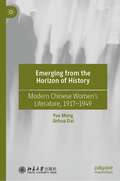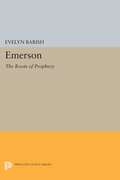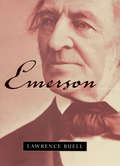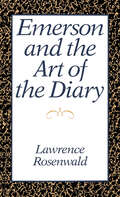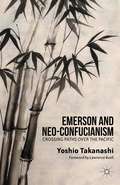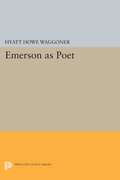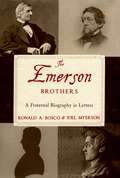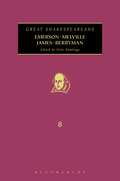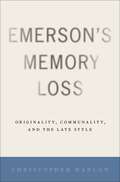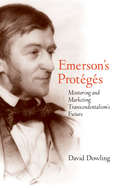- Table View
- List View
The Emerging Contours of the Medium: Literature and Mediality (Thinking Media)
by Richard MüllerThe Emerging Contours of the Medium explores a crucial aspect of media thinking, focusing particularly on the 'mediality' of literature, a medium that remains today on the margins of the theoretical discussion of media. The book was written by a collective of authors based in the Institute of Czech Literature, Czech Academy of Sciences, Czech Republic. Even though interest in the technological and media aspects of literature has been slowly building momentum in the past several decades, from comparative perspectives to written culture to new media, the concept of the medium has not informed this process, and its systematic integration into literary studies has never been effectively carried out. Nor has the specific mediality of literature been successfully integrated into the general concept of media/lity in media science. Contributors to this work provide both an explanation of and solution to this mutual blindness, setting out from the question: What are the conditions for elaborating a media-theoretical framework in which to situate literature as a medium? The Emerging Contours of the Medium, available for the first time in English, is divided into three parts, which correlate to the three main research areas of the principles for a media theory of literature. Part 1 develops a perspective of the (pre)history of media thinking, grounding the principles of the genealogical integration. Part 2 concentrates on and develops the related perspectives of media philosophy and media anthropology. Part 3's main focus is the way media – as dispositifs interlinking the parameters of perception and communication – provide the ground for making emergent media phenomena visible, whether it be between media (in their mutual synergy or discrepancies), between media artefacts, or between human and apparatus.Stanislava Fedrová is Head of the Department of Art Historiography and Theory at the Institute of Art History at the Czech Academy of Sciences, researcher at the Institute of Czech Literature of the Czech Academy of Sciences and Assistant Professor of Literature and Intercultural Communication at Masaryk University, Czech Republic. Her scholarly interests include literary theory, art theory, visual culture and intermedial research, with a focus on the relations between verbal and visual media. She is co-author, with Alice Jedlicková, of Visible Descriptions: Visuality, Suggestivity and Intermediality of Literary Description (2016). Tomáš Chudý works as an independent researcher, translator (Kittler, Luhmann, Taylor etc.) and lawyer for the Czech National Bank. His research interests include media philosophy and the interrelation of technical and humanist paradigms by means of working with signs, as well as interlinking social and economic aspects in technically mediated communication. He has published in scholarly journals, such as Social Studies, and he is the co-author, with Richard Müller et al., of the Czech edition of The Emerging Contours of the Medium: Literature and Mediality (2020). Alice Jedlicková is Senior Researcher at the Institute of Czech Literature of the Czech Academy of Sciences, and Associate Professor of Literature and Intercultural Communication at Masaryk University, Czech Republic. Her research interests include intermedial studies (socio-spatial relations of cultural representations) and its history, literary theory, diachronic poetics and the theory of narrative. She is the editor of, and principle contributor to Narrative Modes of 19th Century Czech Prose (2022), and co-author, with Stanislava Fedrová, of the interdisciplinary inquiry Visible Descriptions: Visuality, Suggestivity and Intermediality of Literary Description (2016). She has published on transmediation as a marker of cultural continuity and on the potential of intermedial approach in education recently. Richard Müller is Senior Researcher at the Institute of Czech Lit
The Emerging Contours of the Medium: Literature and Mediality (Thinking Media)
The Emerging Contours of the Medium explores a crucial aspect of media thinking, focusing particularly on the 'mediality' of literature, a medium that remains today on the margins of the theoretical discussion of media. The book was written by a collective of authors based in the Institute of Czech Literature, Czech Academy of Sciences, Czech Republic. Even though interest in the technological and media aspects of literature has been slowly building momentum in the past several decades, from comparative perspectives to written culture to new media, the concept of the medium has not informed this process, and its systematic integration into literary studies has never been effectively carried out. Nor has the specific mediality of literature been successfully integrated into the general concept of media/lity in media science. Contributors to this work provide both an explanation of and solution to this mutual blindness, setting out from the question: What are the conditions for elaborating a media-theoretical framework in which to situate literature as a medium? The Emerging Contours of the Medium, available for the first time in English, is divided into three parts, which correlate to the three main research areas of the principles for a media theory of literature. Part 1 develops a perspective of the (pre)history of media thinking, grounding the principles of the genealogical integration. Part 2 concentrates on and develops the related perspectives of media philosophy and media anthropology. Part 3's main focus is the way media – as dispositifs interlinking the parameters of perception and communication – provide the ground for making emergent media phenomena visible, whether it be between media (in their mutual synergy or discrepancies), between media artefacts, or between human and apparatus.Stanislava Fedrová is Head of the Department of Art Historiography and Theory at the Institute of Art History at the Czech Academy of Sciences, researcher at the Institute of Czech Literature of the Czech Academy of Sciences and Assistant Professor of Literature and Intercultural Communication at Masaryk University, Czech Republic. Her scholarly interests include literary theory, art theory, visual culture and intermedial research, with a focus on the relations between verbal and visual media. She is co-author, with Alice Jedlicková, of Visible Descriptions: Visuality, Suggestivity and Intermediality of Literary Description (2016). Tomáš Chudý works as an independent researcher, translator (Kittler, Luhmann, Taylor etc.) and lawyer for the Czech National Bank. His research interests include media philosophy and the interrelation of technical and humanist paradigms by means of working with signs, as well as interlinking social and economic aspects in technically mediated communication. He has published in scholarly journals, such as Social Studies, and he is the co-author, with Richard Müller et al., of the Czech edition of The Emerging Contours of the Medium: Literature and Mediality (2020). Alice Jedlicková is Senior Researcher at the Institute of Czech Literature of the Czech Academy of Sciences, and Associate Professor of Literature and Intercultural Communication at Masaryk University, Czech Republic. Her research interests include intermedial studies (socio-spatial relations of cultural representations) and its history, literary theory, diachronic poetics and the theory of narrative. She is the editor of, and principle contributor to Narrative Modes of 19th Century Czech Prose (2022), and co-author, with Stanislava Fedrová, of the interdisciplinary inquiry Visible Descriptions: Visuality, Suggestivity and Intermediality of Literary Description (2016). She has published on transmediation as a marker of cultural continuity and on the potential of intermedial approach in education recently. Richard Müller is Senior Researcher at the Institute of Czech Lit
Emerging Dialogues on Machado de Assis (New Directions in Latino American Cultures)
by Lamonte Aidoo Daniel F. SilvaThe first book-length edited collection on Machado de Assis, this volume offers essays on Machado de Assis' work that offer new critical perspectives not only Brazilian literature and history, but also to social, cultural, and political phenomena that continue to have global repercussions.
Emerging from the Horizon of History: Modern Chinese Women’s Literature, 1917–1949
by Yue Meng Jinhua DaiThis book systematically studies the literary output of female writers in contemporary China within the frame of literary theories of feminism. With tools from psychoanalysis, structuralism and deconstructionism, the two female authors, Meng and Dai, analyze 9 important female writers from 1919 to 1949, including Yin Lu, Xin Bing, Ning Ding, Ailing Zhang. By decade, the authors provide a comprehensive depiction of these female writers' historic-cultural background as well as their reception by critics and audiences. Navigating the complex relation between mainstream literary trends and female writers’ practice, this text represents a landmark of practice of literary feminist criticism within the Chinese language.
Emerson: The Roots of Prophecy
by Evelyn BarishEvelyn Barish began this book partly to inquire into a silence--Ralph Waldo Emerson's failure to discuss or mourn his father, who died when the boy was seven years old. As she probed the meaning of this loss, she found herself tracing the development of an American prophet, producing a detailed intellectual biography of Emerson's early years up to the writing of Nature. In the process she has painted a vivid picture of American society of the period and of Emerson's unusual family--including his aunt, Mary Moody Emerson, a brilliant and eccentric woman, who was described by Emerson as spinning at a higher velocity than all the other tops but who also rode around Concord in her shroud! In the years after the death of William Emerson, Mary Moody Emerson came to help her widowed sister-in-law, Ruth, rear her five sons and thus became a deep influence on the young Ralph Waldo. Barish reveals the complexities of the Emersons' family life, the preoccupations with death and questions of sexual identity in the Romantic fantasies that Emerson wrote as a youth, the emotional struggles of his student years at Harvard, and his private study of the unsettling ideas of the skeptical philosopher David Hume. Pursuing a series of small clues, she clears up the obscurity surrounding the crucial breakdown of his health during the vocational crisis of his twenties. Finally, she traces his path out of fear and self-doubt into autonomy, as he overcame crippling grief after the death of his first wife. Barish makes it clear how Emerson the American classic thinker emerged from a welter of conflicts and handicaps previously obscure to us. How did he free himself from the rigor mortis of his own cultural and personal past--from what he called the "corpse-cold Unitarianism of Brattle Street and Harvard College"--to become the liberator of America from the intellectual shackles of its colonial experience? Her answer redefines Emerson's "self-reliance" not in traditional transcendent or idealistic terms but as the result of real life and hard struggle--experience "passed through the fire of thought."Originally published in 1990.The Princeton Legacy Library uses the latest print-on-demand technology to again make available previously out-of-print books from the distinguished backlist of Princeton University Press. These editions preserve the original texts of these important books while presenting them in durable paperback and hardcover editions. The goal of the Princeton Legacy Library is to vastly increase access to the rich scholarly heritage found in the thousands of books published by Princeton University Press since its founding in 1905.
Emerson: Crossing Paths Over The Pacific
by Lawrence Buell"An institution is the lengthened shadow of one man," Ralph Waldo Emerson once wrote--and in this book, the leading scholar of New England literary culture looks at the long shadow Emerson himself has cast, and at his role and significance as a truly American institution. On the occasion of Emerson's 200th birthday, Lawrence Buell revisits the life of the nation's first public intellectual and discovers how he became a "representative man." Born into the age of inspired amateurism that emerged from the ruins of pre-revolutionary political, religious, and cultural institutions, Emerson took up the challenge of thinking about the role of the United States alone and in the world. With characteristic authority and grace, Buell conveys both the style and substance of Emerson's accomplishment--in his conception of America as the transplantation of Englishness into the new world, and in his prodigious work as writer, religious thinker, and philosopher. Here we see clearly the paradoxical key to his success, the fierce insistence on independence that acted so magnetically upon all around him. Steeped in Emerson's writings, and in the life and lore of the America of his day, Buell's book is as individual--and as compelling--as its subject. At a time when Americans and non-Americans alike are struggling to understand what this country is, and what it is about, Emerson gives us an answer in the figure of this representative American, an American for all, and for all times.
Emerson And The Art Of The Diary
by Lawrence RosenwaldThis first extended literary description and analysis of Emerson's journals, argues that they, and not his essays, are Emerson's masterpiece, constituting one of the greatest commentaries on nineteenth-century America by one of our most acute formal intelligences. First developing the critical methodology needed to examine the journal form, a genre long neglected by literary scholars, Rosenwald goes on to consider how Emerson the diarist found his form and what form he found. Included are comparisons between the journals and Emerson's lectures and essays, other Transcendentalist journals, the German aphorism-book, and books of quotation by Montaigne and Eckermann. Finally, the author gives an account of how, in his old age, Emerson lost his mastery of the form.
Emerson and Neo-Confucianism: Crossing Paths over the Pacific
by Y. TakanashiA comparative investigation of Emerson's Transcendental thought and Zhu Xi's Neo-Confucianism, this book shows how both thinkers traced the human morality to the same source in the ultimately moral nature of the universe and developed theories of the interrelation of universal law and the human mind.
Emerson and the Art of the Diary
by Lawrence RosenwaldThis first extended literary description and analysis of Emerson's journals, argues that they, and not his essays, are Emerson's masterpiece, constituting one of the greatest commentaries on nineteenth-century America by one of our most acute formal intelligences. First developing the critical methodology needed to examine the journal form, a genre long neglected by literary scholars, Rosenwald goes on to consider how Emerson the diarist found his form and what form he found. Included are comparisons between the journals and Emerson's lectures and essays, other Transcendentalist journals, the German aphorism-book, and books of quotation by Montaigne and Eckermann. Finally, the author gives an account of how, in his old age, Emerson lost his mastery of the form.
Emerson as Poet
by Hyatt Howe WaggonerSince Yvor Winters' famous denunciation of Ralph Waldo Emerson and his writings in the 1930s, major critics have been silent on the subject, and Emerson scholars have generally avoided critical evaluation. Hyatt H. Waggoner reopens the debate, arguing that past criticism of Emerson has been limited by the inevitable but unfortunate influences of cultural relativism and personal taste. He suggests that by concentrating on the stabilities, on the recognizably similar patterns of response by critics to Emerson as poet, one can arrive at a portrait that transcends changing cultures and preferences. His book thus combines a full critical re-evaluation of Emerson's poetry with a thoughtful commentary on the ways in which critics and readers approach poetry.Originally published in 1975.The Princeton Legacy Library uses the latest print-on-demand technology to again make available previously out-of-print books from the distinguished backlist of Princeton University Press. These editions preserve the original texts of these important books while presenting them in durable paperback and hardcover editions. The goal of the Princeton Legacy Library is to vastly increase access to the rich scholarly heritage found in the thousands of books published by Princeton University Press since its founding in 1905.
The Emerson Brothers: A Fraternal Biography in Letters
by Ronald A. Bosco Joel MyersonThe Emerson Brothers: A Fraternal Biography in Letters is a narrative and epistolary biography drawn from the unpublished lifelong correspondence exchanged among four brothers: Charles Chauncy, Edward Bliss, Ralph Waldo, and William Emerson. This is an extensive correspondence, for not counting Waldo's previously published letters, there are 768 letters exchanged among the brothers and an additional 483 unpublished letters from the brothers to their aunt Mary Moody Emerson, mother Ruth Haskins Emerson, and Charles' fiancée Elizabeth Hoar, among others. While lesser figures might have faltered under the burden of having been born an Emerson, with social, political, and ecclesiastic roots extending back to the first century of New England settlement, the brothers' letters reveal that all were invigorated by a shared sense of origin and aspired to make a significant reputation for themselves. Across six richly developed chapters, the signal events and friendships that shaped the Emerson brothers' lives are strung together to reveal a remarkable family culture. For the first time, The Emerson Brothers treats the illustrious history of the Emerson family in America as a foreshadowing of expectations the brothers inherited; defines the extent of Waldo's debt to William for his encounter with German Biblical Criticism; develops Charles' and Edward's incredibly promising but ultimately tragic lives; examines the profound emotional and intellectual impact of Aunt Mary on the younger Emersons; considers the three-year courtship between Charles and Elizabeth Hoar in the context of Waldo's own marriages; and studies the brothers' preoccupation with financial security for "the family" (revealing, too, that finances were at least as powerful a motivation behind Waldo's 1832 resignation from Boston's Second Church as were the death of his first wife and his religious doubts). This biography approaches Waldo's inner life in a way that makes him a figure to imagine personally by portraying him in relation to his brothers who are his intellectual equals. It offers an imaginative social and cultural history of one of our oldest and most gifted families, unique players in a period often considered to be the "American Renaissance."
The Emerson Effect: Individualism and Submission in America
by Christopher NewfieldThis book presents a revisionist account of Ralph Waldo Emerson's influential thought on individualism, in particular his political psychology. Christopher Newfield analyzes the interplay of liberal and authoritarian impulses in Emerson's work in various domains: domestic life, the changing New England economy, theories of poetic language, homoerotic friendship, and racial hierarchy. Focusing on neglected later writings, Newfield shows how Emerson explored the tensions between autonomy and community—and consistently resolved these tensions by "abandoning crucial elements of both" and redefining autonomy as a kind of liberating subjection. He argues that in Emersonian individualism, self-determination is accompanied by submission to authority, and examines the influence of this submissive individualism on the history of American liberalism. In a provocative reading of Emerson's early and neglected later works, Newfield analyzes Emerson's emphasis on collective, or "corporate", world-building, rather than private possession. Tracing the development of this corporate individualism, he illuminates contradictions in Emerson's political outlook, and the conjunctions of liberal and authoritarian ideology they produced.
Emerson, Melville, James, Berryman: Great Shakespeareans: Volume VIII (Great Shakespeareans)
by Peter RawlingsA comprehensive analysis of the most important Shakespearean critics, editors, actors and directors. This volume focuses on Shakespeare's reception by major American writers and poets.
Emerson, Melville, James, Berryman: Great Shakespeareans: Volume VIII (Great Shakespeareans)
by Peter RawlingsA comprehensive analysis of the most important Shakespearean critics, editors, actors and directors. This volume focuses on Shakespeare's reception by major American writers and poets.
Emerson, Whitman, and the American Muse
by Jerome LovingLoving finds in the lives and works of the two writers a symbiosis of spirit that transcends the question of literary influence. Tracing the parallel careers of Emerson and Whitman, the author shows how each served his literary apprenticeship, moved beyond his vocation, prospered, and, finally, declined in his literary achievements. In both cases, Loving follows his subject from vision to wisdom and, along the way, examines the aspects of the relationship that have aroused controversy.Originally published in 1982.A UNC Press Enduring Edition -- UNC Press Enduring Editions use the latest in digital technology to make available again books from our distinguished backlist that were previously out of print. These editions are published unaltered from the original, and are presented in affordable paperback formats, bringing readers both historical and cultural value.
Emerson's English Traits and the Natural History of Metaphor
by David LaRoccaMetaphors are ubiquitous and yet-or, for that very reason-go largely unseen. We are all variously susceptible to a blindness or blurry vision of metaphors; yet even when they are seen clearly, we are left to situate the ambiguities, conflations and contradictions they regularly present-logically, aesthetically and morally.David LaRocca's book serves as a set of 'reminders' of certain features of the natural history of our language-especially the tropes that permeate and define it. As part of his investigation, LaRocca turns to Ralph Waldo Emerson's only book on a single topic, English Traits (1856), which teems with genealogical and generative metaphors-blood, birth, plants, parents, family, names and race.In the first book-length study of English Traits in over half a century, LaRocca considers the presence of metaphors in Emerson's fertile text-a unique work in his expansive corpus, and one that is regularly overlooked. As metaphors are encountered in Emerson's book, and drawn from a long history of usage in work by others, a reader may realize (or remember) what is inherent and encoded in our language, but rarely seen: how metaphors circulate in speech and through texts to become the lifeblood of thought.
Emerson's English Traits and the Natural History of Metaphor
by David LaRoccaMetaphors are ubiquitous and yet-or, for that very reason-go largely unseen. We are all variously susceptible to a blindness or blurry vision of metaphors; yet even when they are seen clearly, we are left to situate the ambiguities, conflations and contradictions they regularly present-logically, aesthetically and morally.David LaRocca's book serves as a set of 'reminders' of certain features of the natural history of our language-especially the tropes that permeate and define it. As part of his investigation, LaRocca turns to Ralph Waldo Emerson's only book on a single topic, English Traits (1856), which teems with genealogical and generative metaphors-blood, birth, plants, parents, family, names and race.In the first book-length study of English Traits in over half a century, LaRocca considers the presence of metaphors in Emerson's fertile text-a unique work in his expansive corpus, and one that is regularly overlooked. As metaphors are encountered in Emerson's book, and drawn from a long history of usage in work by others, a reader may realize (or remember) what is inherent and encoded in our language, but rarely seen: how metaphors circulate in speech and through texts to become the lifeblood of thought.
Emerson's Ghosts: Literature, Politics, and the Making of Americanists
by Randall FullerIt is increasingly commonplace to find scholars who circle back to Ralph Waldo Emerson and his intellectual heirs as a way of better understanding contemporary social and aesthetic contexts. Why does Emerson's cultural legacy continue to influence writers so forcefully? In this innovative study, Randall Fuller examines the way pivotal twentieth-century critics have understood and deployed Emerson as part of their own larger projects aimed at reconceiving America. He examines previously unpublished material and original research on Van Wyck Brooks, Perry Miller, F.O. Matthiessen, and Sacvan Bercovitch along with other supporting thinkers. An engaging institutional history of American literary studies in the twentieth century, Emerson's Ghosts reveals the unexpected convergent forces that have shaped American cultural history in lasting ways.
Emerson's Literary Philosophy
by Reza HosseiniThis book situates Ralph Waldo Emerson in the tradition of philosophy as “spiritual exercise”, arguing that the defining feature of his literary philosophy is the conviction that there is an inherent link between moral persuasion and literary excellence. Hosseini persuasively argues that the Emersonian project can be viewed as an extension of Socrates’ call for a return to the beginning of philosophy, to search for a way of revolutionizing our ways of seeing from within. Examining Emerson’s provocative style of writing, Hosseini contends that his prose is shaped by a desire to bring about psychagogia, or influencing the soul through the power of words. This book furthermore examines the evolving nature of Emerson’s thoughts on “scholarly action” and its implications, his religious temperament as an aesthetic experience of the world through wonder, and the reasons for a resounding acknowledgment of despair in his essay “Experience.” In the concluding chapter, Hosseini explores the depth of Emerson’s engagement with the classical Persian poets and argues that what we may call his “literary humanism” is informed by Persian Adab, exemplified in the writings of Rumi, Hafiz, and Saadi. Weaving together themes from Persian philosophy and Emersonian transcendentalism, Hosseini establishes Emerson’s way of seeing as refreshingly relevant, showing that the questions he tackled in his writings are as pressing today as they were in his time.
Emerson's Memory Loss: Originality, Communality, and the Late Style
by Christopher HanlonRalph Waldo Emerson's dementia, an ordeal that marked his final two decades, has never been a secret among those who study Emerson's life. Still, few have focused on the period of Emerson's decline. Thus, his later thinking has succumbed to a process of critical forgetting too often ignored by scholars if not excluded from his oeuvre altogether. And yet Emerson's late output, composed as his patterns of cognition transformed profoundly, stages a reconsideration of interests that had preoccupied him for decades: the continuum of human thought and the rest of nature, the bearing of the individual toward the collective, the mind's relationship with the body. Emerson's Memory Loss presents an archive of texts documenting Emerson's intellectual, affective, and associative states during his late phase, along with the varying forms of shared connection from which these works emerge. It is also about the way such texts connect Emerson with a stream of thought in America, coursing through the works of other nineteenth-century writers and thinkers adjacent to Emerson, that emphasizes the aggregate over the singular, the social over the solipsistic, the engaged over the distant, and the many over the one. Hanlon attends to manuscripts and publications marking Emerson's collaborations with others which Emerson himself articulated as his most important work-texts written even as his ability to do so independently waned. Hanlon measures its resonance across broader strains of U.S. culture familiar to Margaret Fuller, Herman Melville, Walt Whitman, and more.
Emerson's Memory Loss: Originality, Communality, and the Late Style
by Christopher HanlonRalph Waldo Emerson's dementia, an ordeal that marked his final two decades, has never been a secret among those who study Emerson's life. Still, few have focused on the period of Emerson's decline. Thus, his later thinking has succumbed to a process of critical forgetting too often ignored by scholars if not excluded from his oeuvre altogether. And yet Emerson's late output, composed as his patterns of cognition transformed profoundly, stages a reconsideration of interests that had preoccupied him for decades: the continuum of human thought and the rest of nature, the bearing of the individual toward the collective, the mind's relationship with the body. Emerson's Memory Loss presents an archive of texts documenting Emerson's intellectual, affective, and associative states during his late phase, along with the varying forms of shared connection from which these works emerge. It is also about the way such texts connect Emerson with a stream of thought in America, coursing through the works of other nineteenth-century writers and thinkers adjacent to Emerson, that emphasizes the aggregate over the singular, the social over the solipsistic, the engaged over the distant, and the many over the one. Hanlon attends to manuscripts and publications marking Emerson's collaborations with others which Emerson himself articulated as his most important work-texts written even as his ability to do so independently waned. Hanlon measures its resonance across broader strains of U.S. culture familiar to Margaret Fuller, Herman Melville, Walt Whitman, and more.
Emerson's Protégés: Mentoring and Marketing Transcendentalism's Future
by Prof. David DowlingIn the late 1830s, Ralph Waldo Emerson, American essayist, poet, lecturer, and leader of the Transcendentalist movement, publicly called for a radical nationwide vocational reinvention, and an idealistic group of collegians eagerly responded. Assuming the role of mentor, editor, and promoter, Emerson freely offered them his time, financial support, and anti-materialistic counsel, and profoundly shaped the careers of his young acolytes—including Henry David Thoreau, renowned journalist and women’s rights advocate Margaret Fuller, and lesser-known literary figures such as Samuel Ward and reckless romantic poets Jones Very, Ellery Channing, and Charles Newcomb. Author David Dowling’s history of the professional and personal relationships between Emerson and his protégés—a remarkable collaboration that alternately proved fruitful and destructive, tension-filled and liberating—is a fascinating true story of altruism, ego, influence, pettiness, genius, and the bold attempt to reshape the literary market of the mid-nineteenth century.
Emerson's Romantic Style
by Julie K. EllisonProfessor Ellison demonstrates that the characteristic difficulties of Emerson's prose--its repetitiveness, discontinuity, and tonal peculiarities--are motivated by his use of interpretation to free himself from recurringly intimidating aspects of tradition.Originally published in 1984.The Princeton Legacy Library uses the latest print-on-demand technology to again make available previously out-of-print books from the distinguished backlist of Princeton University Press. These editions preserve the original texts of these important books while presenting them in durable paperback and hardcover editions. The goal of the Princeton Legacy Library is to vastly increase access to the rich scholarly heritage found in the thousands of books published by Princeton University Press since its founding in 1905.
Emerson's Sublime Science (Romanticism in Perspective:Texts, Cultures, Histories)
by E. WilsonEmerson's Sublime Science explores relationships among Emerson's poetics, theory of the sublime, and engagement with electromagnetism. The book illustrates how Davy's chemistry and Faraday's physics revealed to Emerson a sublime universe in which matter is boundless electrical force. It argues that Emerson translated this discovery into a sublime writing style crafted to galvanize readers with the insight that matter is energy. In illuminating Emerson's project, this study also uncovers connections among British Romanticism, American Romanticism, and nineteenth-century science.
Emerson's Transatlantic Romanticism
by D. GreenhamThis book provides an original account of Emerson's creative debts to the British and European Romantics, including Coleridge and Carlyle, firmly locating them in his New England context. Moreover this book analyses and explains the way that his thought shapes his unique prose style in which idea and word become united in an epistemology of form.



